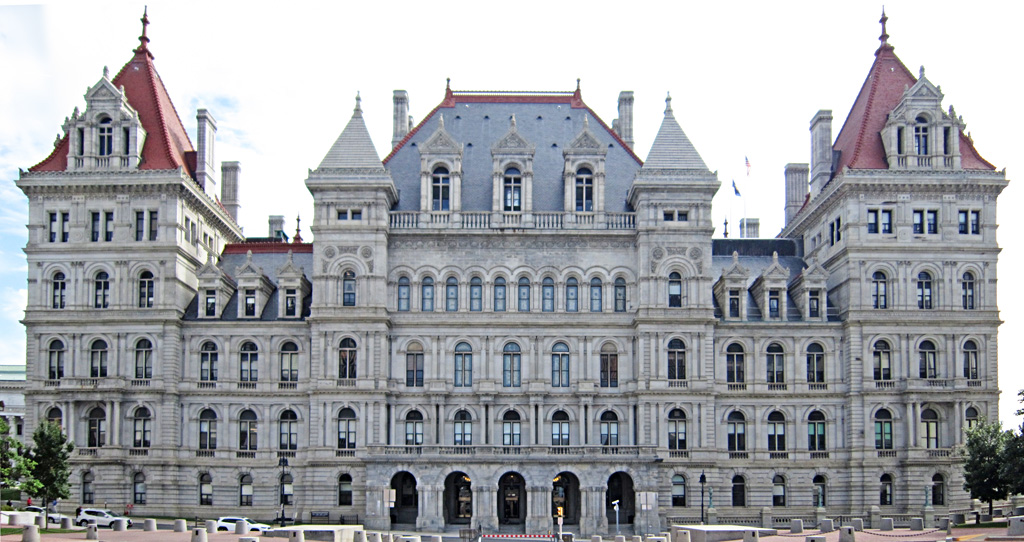 NY01 – State Capitol
NY01 – State CapitolAlbany, NY
I don't normally pay much attention to government buildings, but there is always an exception which proves the rule. The state capitol building of New York is almost unique in that it quite adamantly rejects the cliched design of most state capitols, which invariably seem to involve a classical Greek design with two wings on either side of a St. Paul's dome. The capitol building of New York, by contrast, is resolutely and spectacularly Victorian, which is why I am attracted to it. This is a view of its southern side.
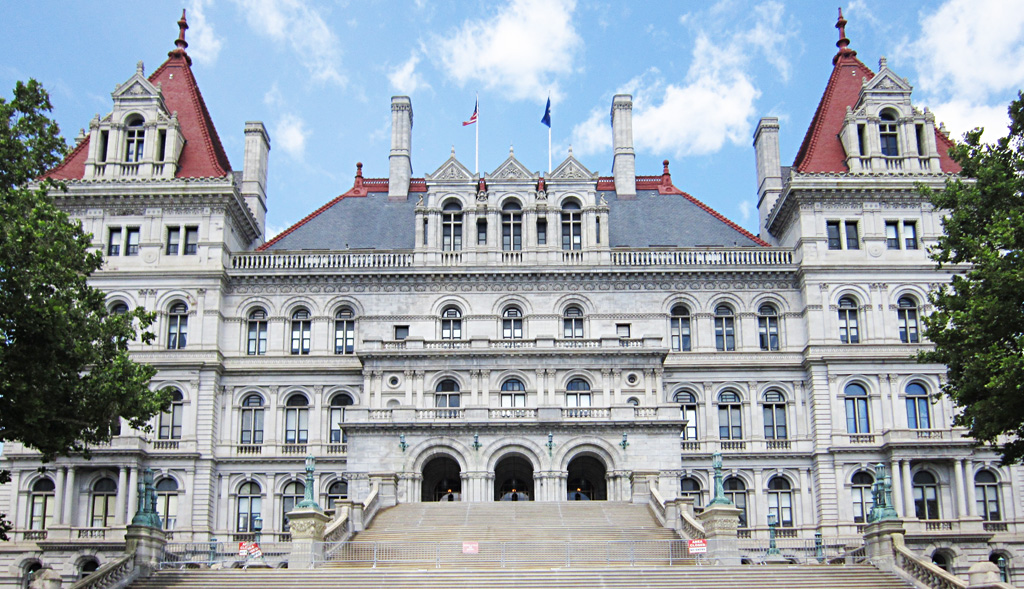 NY02 – State Capitol
NY02 – State CapitolAlbany, NY
This is a view of the eastern side of the capitol building. This side, with its huge staircase, was once the main entrance, but alas. After 9/11 the grand entrance was permanently closed and all traffic is now routed through the more defensible northern and southern entrances. I suppose this kind of thing is inevitable nowadays, but after eight years one imagines that they could come up with a more elegant "Entrance Closed" notice than a cheesy wire fence with sloppy red signs tacked to it.
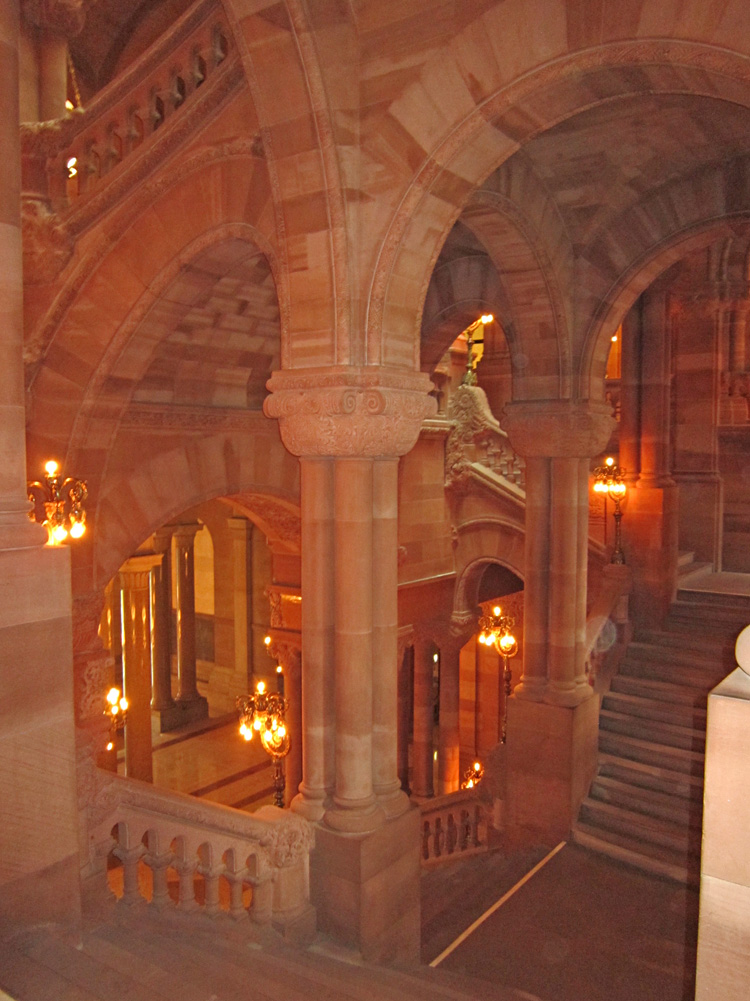 NY03a – Capitol Interior
NY03a – Capitol InteriorAlbany, NY
The capitol of New York took 32 years to build, went through at least five major architects, and cost $25 million in 19th century dollars. The official estimate is that it would cost $500 million to recreate the capitol today, but I completely disagree with that estimate. I think the real cost would be closer to two billion, which means that of all the capitol buildings which exist in the United States now, including that of the federal government, the New York state capitol would be by far the most expensive to build again. As evidence I offer the above two photos of its amazing exterior, and also these photos of its interior. The photo at right represents my attempt to capture the mind-boggling splendor of its western staircase, which was designed in Romanesque Revival style by H. H. Richardson himself. You are looking at the staircase from a second-floor landing. The staircase rises from the first floor in the center of the photo, then reaches a partial landing where it splits into two smaller staircases rising to either side. Those two stairs then reach secondary landings so that they can turn and wrap around the incredible columns of the main stairwell. And then this is repeated for floors three and four. The resulting view if one stands at the bottom of the staircase and looks upward is almost beyond description and certainly well beyond the ability of a pocket camera to capture. A professional photographer with the best of equipment and a lot of well-executed "light painting" might be able to capture a decent photo of the well, but it still wouldn't equal the three-dimension grandeur of the actual thing. Most of the interior of the New York capitol is equally magnificent, and includes two other massive staircases designed by other architects in Gothic and Renaissanse styles. They don't build them like this anymore, folks.
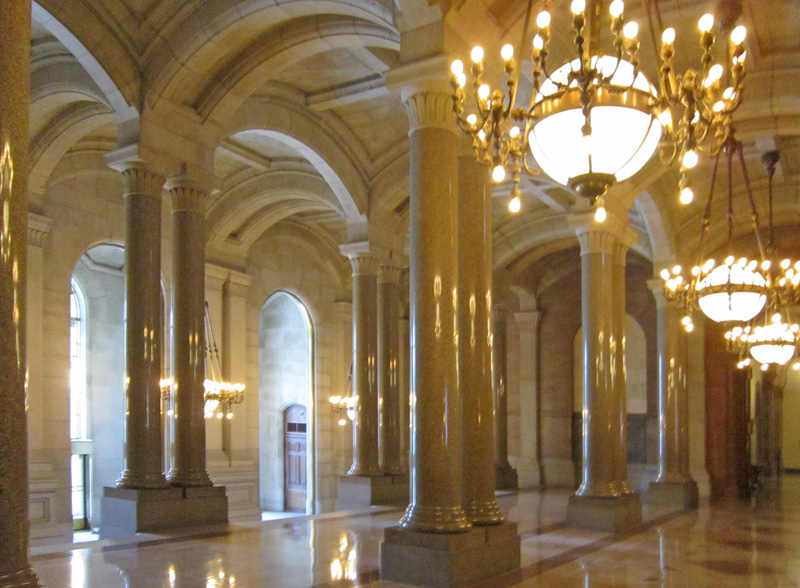 NY03b – Capitol Interior
NY03b – Capitol InteriorAlbany, NY
Here is a shot of a "typical" corridor in the New York capitol building. The two-story columns are solid marble, of course. The capitol was never really finished, because in the end it simply overran all its cost estimates by so much (It was originally estimated to cost only four million dollars.) that Governor Theodore Roosevelt finally decided it was complete enough. He ordered all work on the building to end, and to this day there are stubs of stone in the House Chamber which haven't been carved into gargoyles like the other decorative beams because the workmen simply hadn't gotten to them yet when Roosevelt issued his order.
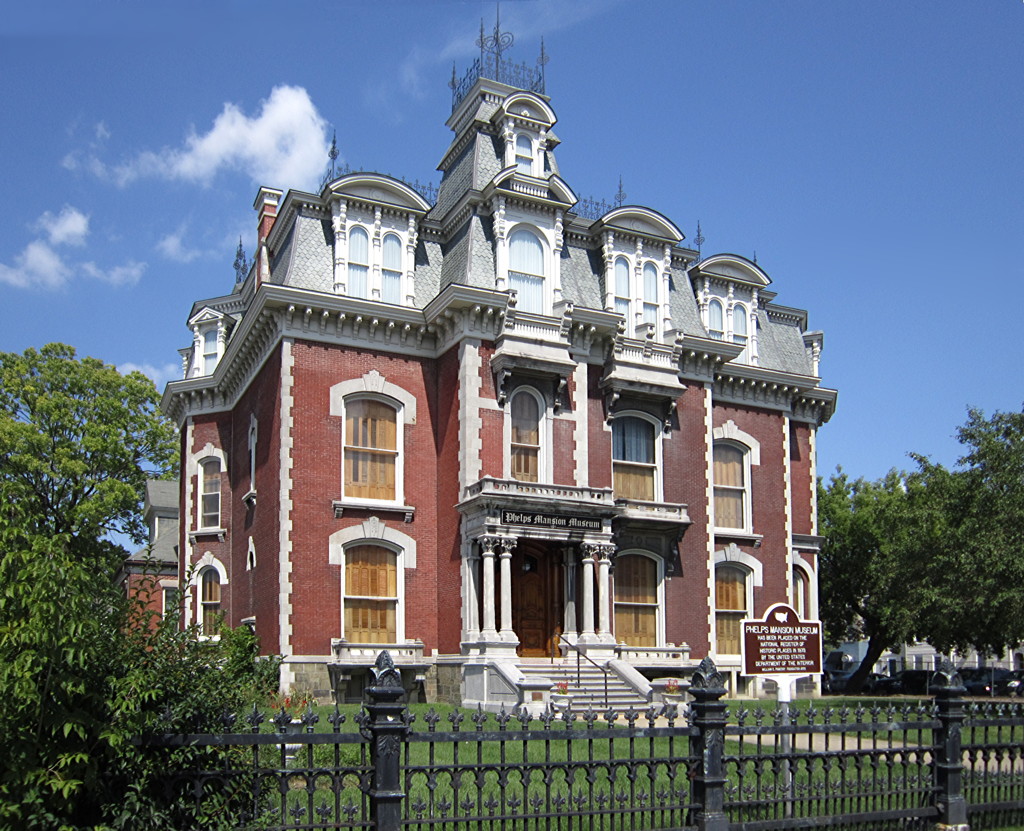 NY04 – Second Empire
NY04 – Second EmpireBinghampton, NY
This is the Phelps Mansion. The first two stories of the house are in splendid condition and contain some beautiful dark woodwork. Unfortunately, by the 1940's the entire third story of the house had deteriorated so badly that it was completely removed and the house sat with only a flat roof on it for 50 years. The current third story is a very carefully reconstructed shell (taken from old photographs) that simply sits on top of the flat roof. It looks wonderful, but it is just a shell.
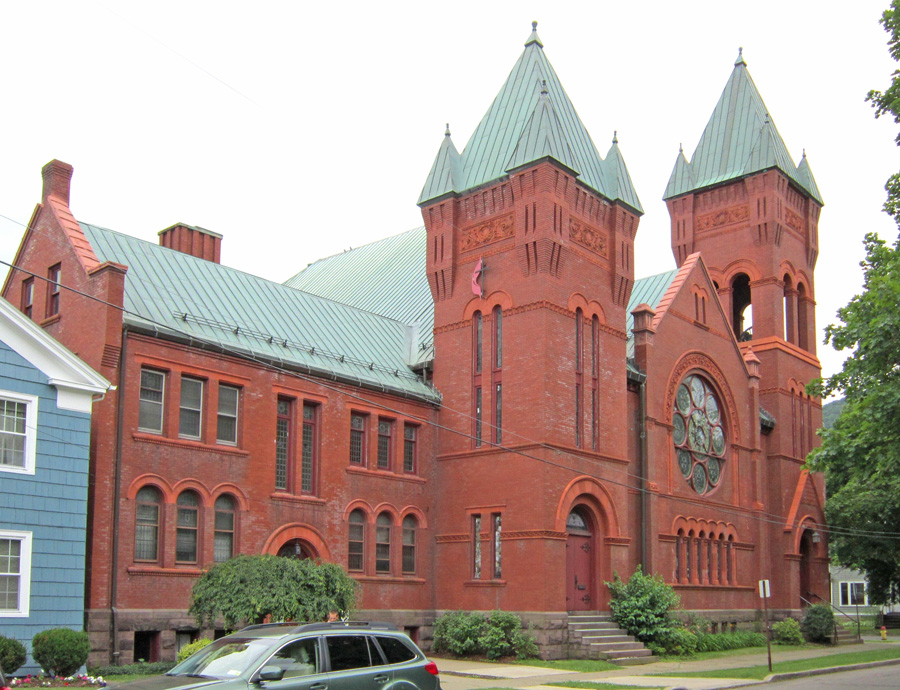 NY05 – Romanesque Church
NY05 – Romanesque ChurchCorning, NY
As with government buildings, I don't normally pay much attention to churches, but when you see an example of a Romanesque Revival church as nice as this one, you stop and take a photo. I was forced to use this rather oblique angle due to the massive trees planted directly in front of the entrance.
I was really in Corning to see the Rockwell Museum of Western Art, but as things turned out, the buildings around the art exhibit were more interesting to me than what was inside them.
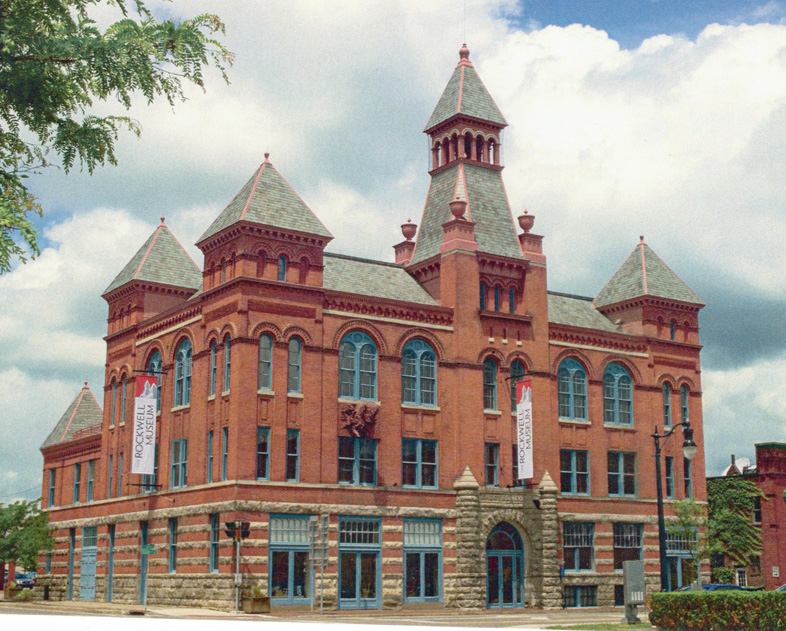 NY06 – Romanesque Revival
NY06 – Romanesque RevivalCorning, NY
This is a picture postcard which shows the former town hall of Corning. I presume they stopped all the traffic around the building and allowed the photographer to do his work from the middle of the four-lane intersection, because I do not see how one could take this photo otherwise. The building now houses the Rockwell Museum, which contains art about the Old West, including some Frederic Remington sculptures and a large Albert Bierstadt painting. Me being me, of course, I decided that the old town hall was more interesting than the art, since it is a fine example of a Queen Anne – Romanesque public building.
Apropo of nothing, Corning is much better known for its famous museum of glass, given that the Corning Glass company has been headquartered there for decades. However (rant up ahead), I have NO interest in glass. I do not find it to be especially beautiful or interesting, and I could not possibly care less about how it is made, what its history is, or how its chemistry works. I do find some stained glass windows to be beautiful, but only for the designs impressed into them. The glass itself is just a type of canvas, as far as I am concerned. So, I sped right past the glass museum at about 50 miles per hour, and made a beeline for the downtown, where the far lesser-known Rockwell Museum is located.
 NY07a – Queen Anne
NY07a – Queen AnneCortland, NY
I do not have much to say about this house, except that it is a very nice, quintessential Queen Anne. It houses the offices of an interior design group today. It is located on a much less fashionable street far from the Millionaires Road discussed below, so perhaps the original owner was a frugal sort who wished to build his house on cheaper land.
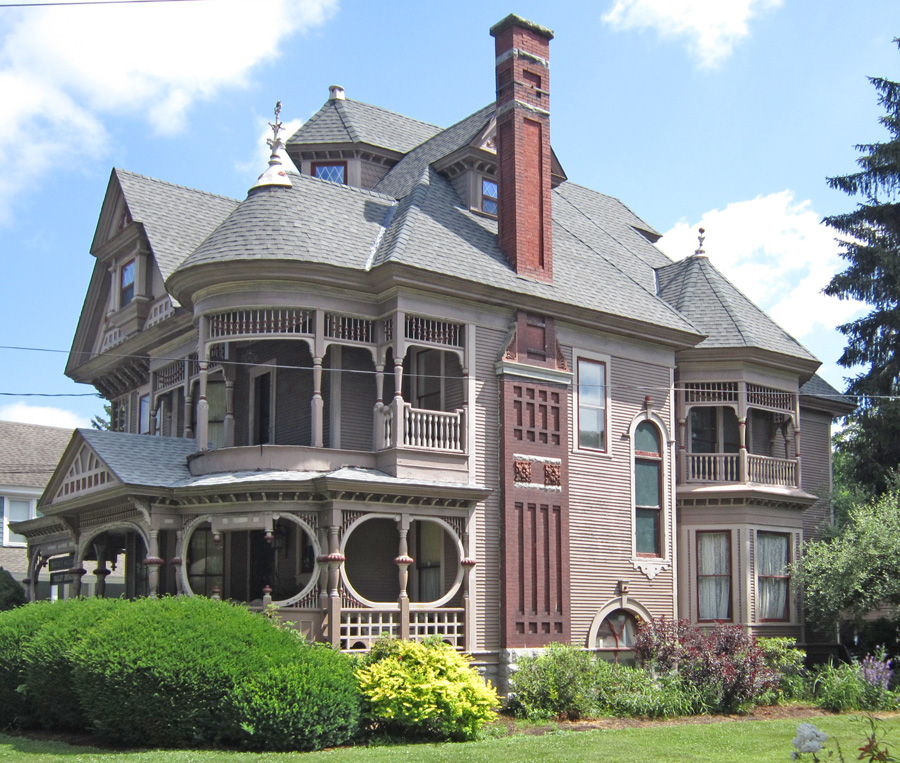 NY07b – Queen Anne
NY07b – Queen AnneCortland, NY
This is a alternative view of the house above which shows off the many porches better, and also illustrates the nice brickwork on the chimney.
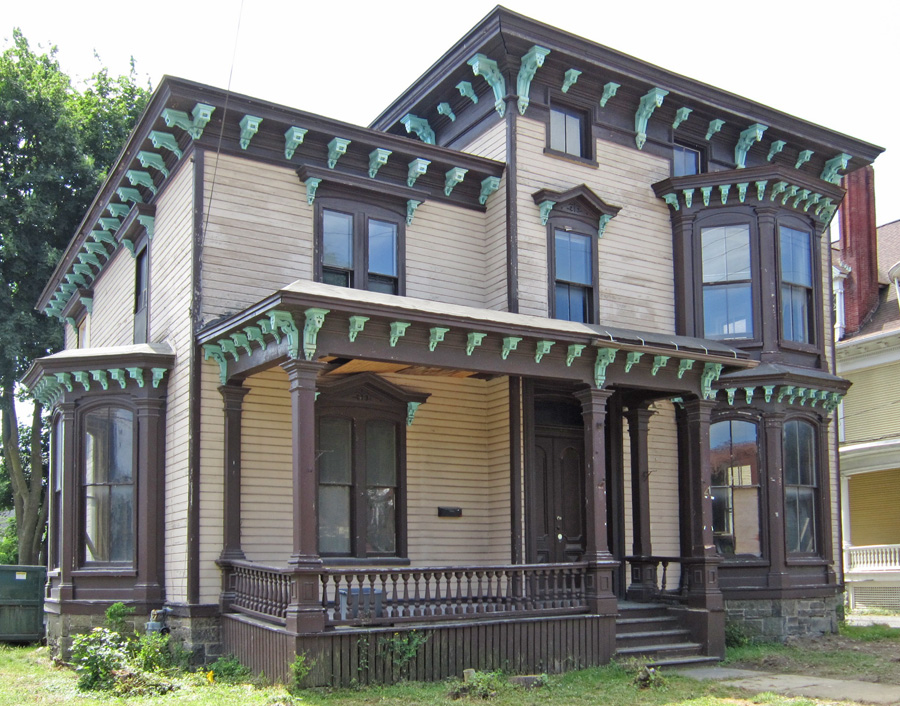 NY08 – Italianate
NY08 – ItalianateCortland, NY
This is one of the smaller and less-impressive houses on Cortland's Tompkins Street, and it has clearly seen better times. However, there were renovations going on when I visited, and the green brackets are all new (although they appear to be made of resin rather than wood), so perhaps a revival of its former glory lies ahead. In one of those unbelievable coincidences which would make you roll your eyes if it happened in a movie, an elderly gentleman walked up to me just as I was photographing the house, and introduced himself as someone who had once lived in the house when he was a boy! He told me that his dad was a lawyer, but that the house was beginning to fall into disrepair even back then, so rather than pouring money into it they had moved out. He also gave me some tidbits about some of the other houses along Tompkins Street, and those are included below.
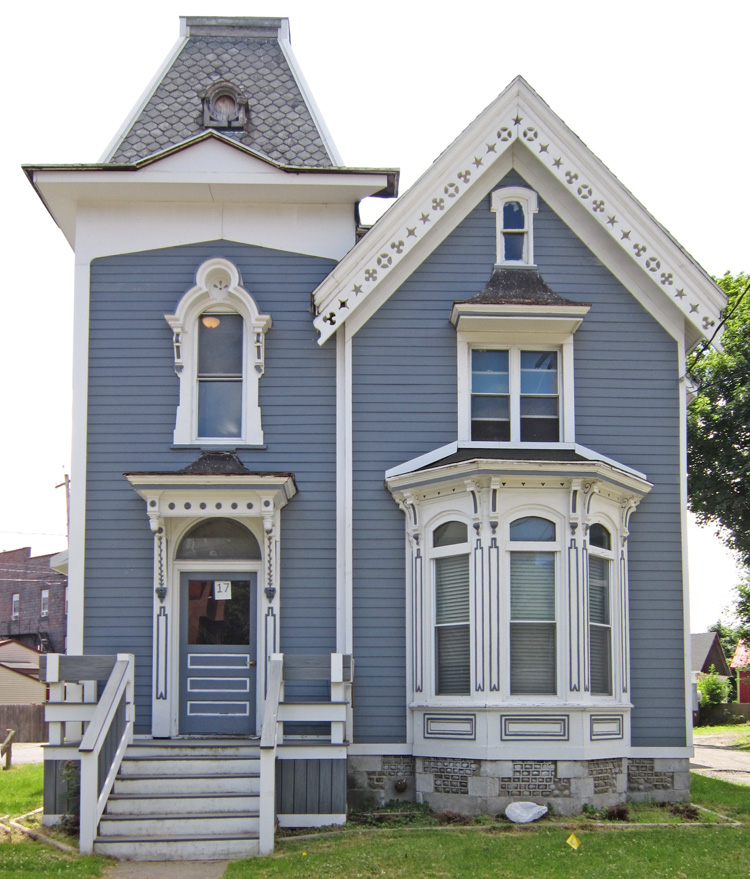 NY09 – Folk Victorian
NY09 – Folk VictorianCortland, NY
This is one of those small Victorian houses that you probably wouldn't even notice if you were driving along Tompkins Street, but I was walking and I noticed it, so I stopped and took this photo.
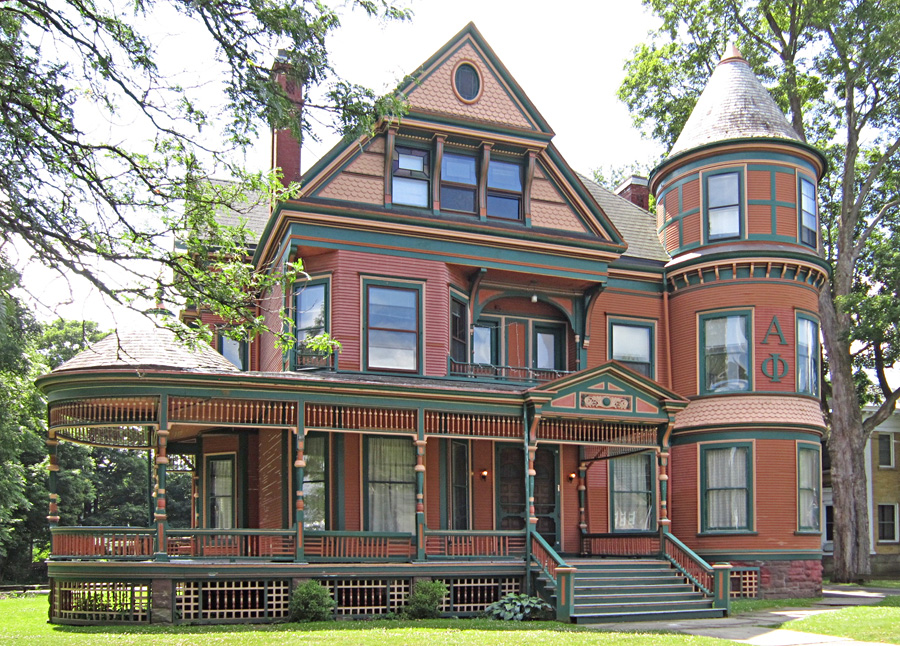 NY10 – Queen Anne
NY10 – Queen AnneCortland, NY
This is the Fitzgerald House, so named after the family of wagon merchants who built it, and it is rather famous in Victorian house circles. It was used for the cover photo of the book "Victorian Exterior Decoration" by Moss & Winkler, and is said to be authentically painted in the same period colors as when it was new. It is also next door to the more-famous Wickwire Mansion (see below). In 1902, like a scene from a romantic novel, one of the Fitzgerald's daughters married the Boy Next Door. That is to say, she married Charles Wickwire, one of the sons of Chester Wickwire.
Today the house is the home of the Alpha Phi sorority at the State University of New York at Cortland, so the interior has been significantly altered and repurposed. However, since folks just don't buy horse-drawn wagons like they used to, it is quite probable that the house would have fallen into a sorry state by now or even have been demolished if not for its purchase by the sorority. A bit of interior remodeling is a small price to pay for historic house preservation.
 NY11a – French Chateau
NY11a – French ChateauCortland, NY
This is the Wickwire Mansion, also known locally as the 1890 House since it was built then. In 1873, almost by accident, Chester Wickwire invented a machine for weaving wires together, thereby creating an inexpensive way to manufacture screen wire, chicken wire, and other such products. He and his brother went into the wire business, and eventually expanded their factory in Cortland into a huge enterprise which for a time turned this small town in upstate New York into the second-largest producer of woven wire products in the country. The 1890 House was one of the fruits of their labor.
This "Chateauesque" mansion is famous in another way, because it is virtually a duplicate of the Bailey Mansion in New York City. The apparently-true story here is that Wickwire saw the Bailey Mansion while on a trip to the city, and was so stuck by it that he contacted the architect who had built it and asked for a duplicate to be constructed in Cortland! Wickwire descendents occupied the mansion until 1973, whereupon it became a private museum.
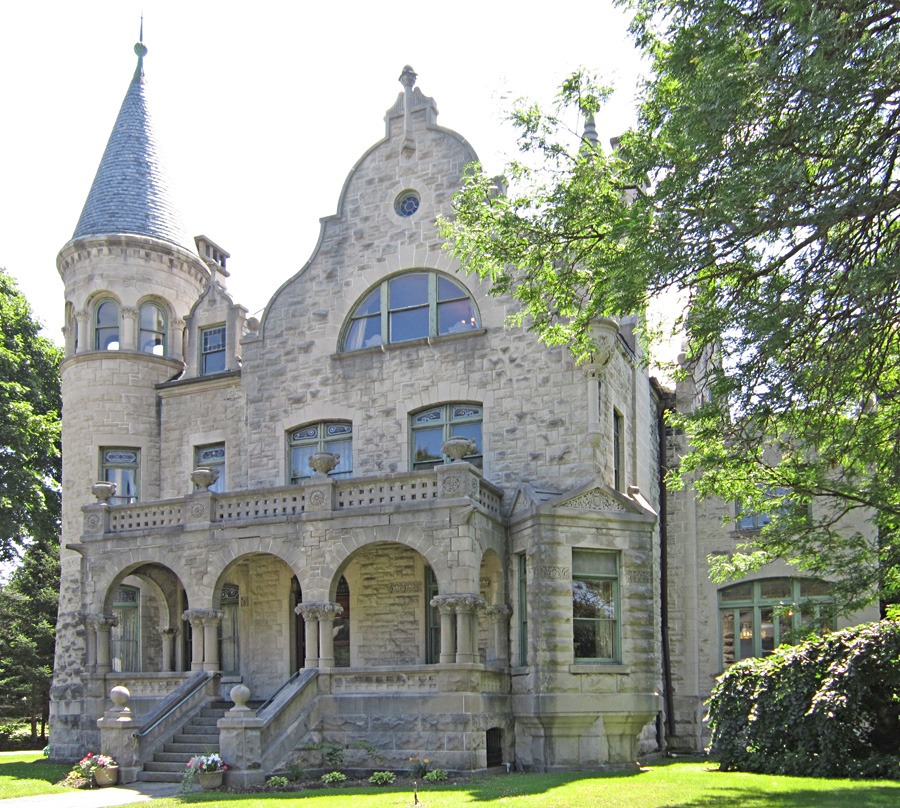 NY11b – French Chateau
NY11b – French ChateauCortland, NY
This is a slightly different view of the Wickwire Mansion. (I couldn't decide which view looked the best, so I finally settled on showing both of them.) Like many independent Victorian manufacturers, the patents of the Wickwire brothers eventually expired and they were pushed out of business by much larger corporate manufacturers who could employ economies of scale to produce the same product at lower cost. The Wickwires eventually left town to manage other investments, and today there is nothing left whatever of the old factories.
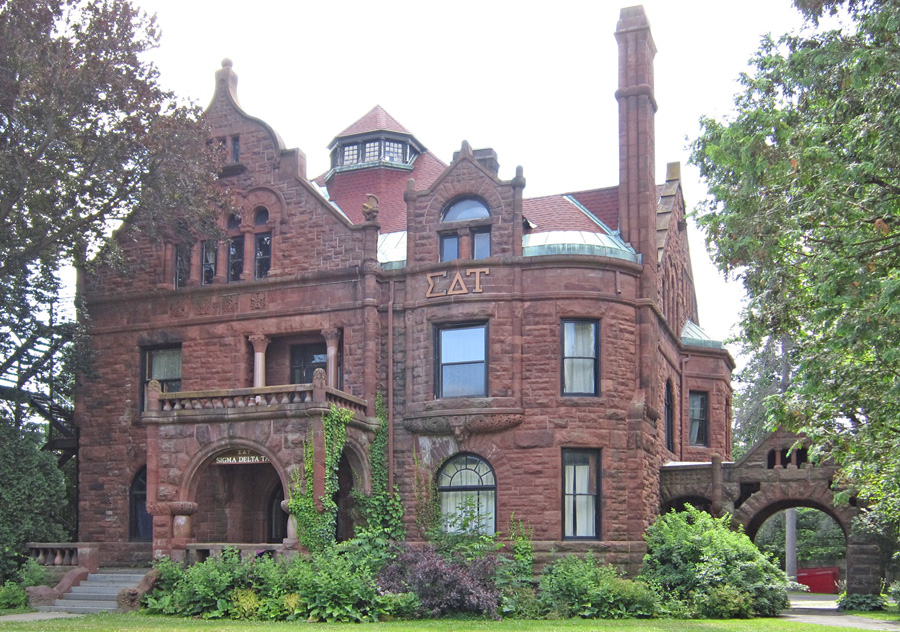 NY12 – Romanesque Revival
NY12 – Romanesque RevivalCortland, NY
This quite handsome red-sandstone mansion was built by Chester Wickwire's brother, Theodore. It is perhaps two blocks from the 1890 House on Tompkins Street. Like the Fitzgerald House, it was also rescued from the wrecking ball by the State University of New York at Cortland, and it is today home to the Sigma Delta Tau fraternity.
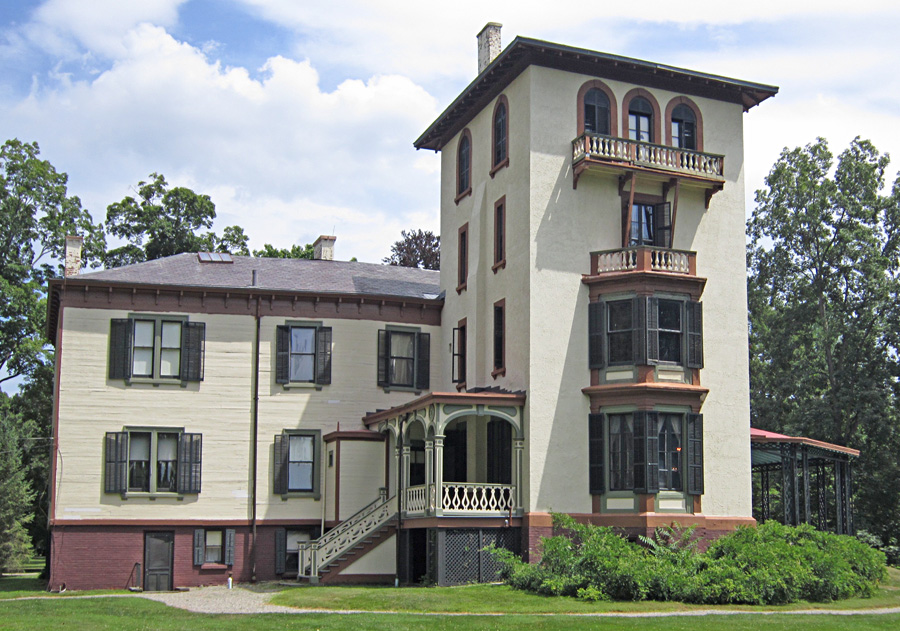 NY13a – Italianate
NY13a – ItalianatePoughkeepsie, NY
Locust Grove is the name of a rural 180-acre estate near Poughkeepsie which was once owned by Samuel Morse, the famous inventor of the telegraph. The main house is a very early Italianate (circa 1850) that Morse built on the estate after he struck it rich with his invention. Before that time he was an oil portrait painter whose canvases showed surprising talent (surprising to this writer, anyway) but whose sales could not support the lifestyle and summer house of a country gentleman. These days Locust Grove is open to the public, and contains many of Morse's paintings and other memorabilia.
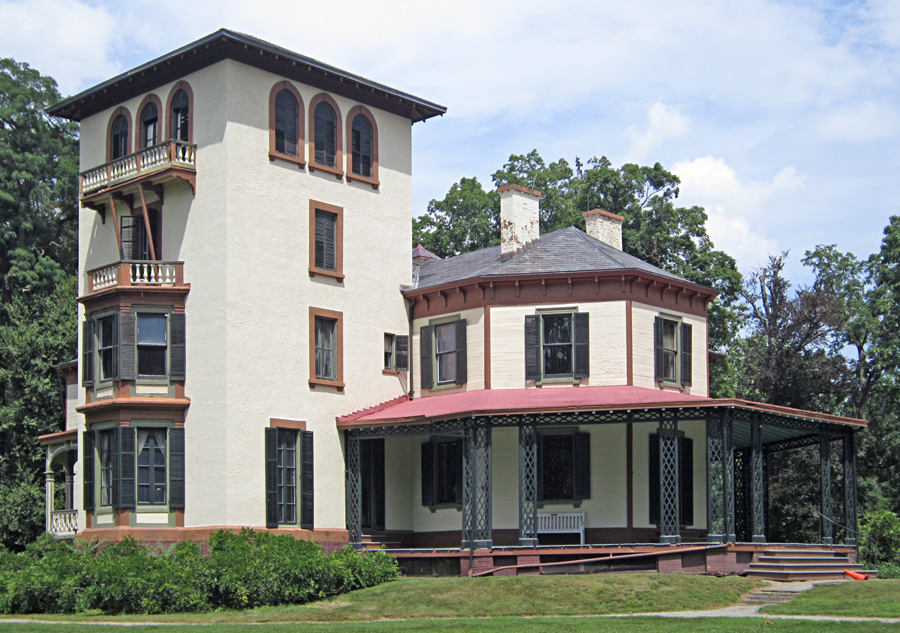 NY13b – Italianate
NY13b – ItalianatePoughkeepsie, NY
When Morse purchased Locust Grove in 1847, the house was only a small Greek Revival box built in 1830. He asked his friend, the famous architect Alexander Jackson Davis, to help him improve the house, and together they expanded it in the latest, most avante garde style – which at that time was the Italianate. They added the four-story Tuscan-style tower, and the octagonal wing and porch shown here. The prominent Young family of Poughkeepsie acquired the property in 1895 following Morse's death, and they modernized it to include running water and electric light in 1901. In 1975 Annette Young, the last person to live in the house, created a nonprofit foundation to preserve the house exactly as it had been when she was a child, and thus the house contains an excellent collection of Edwardian furniture and art.
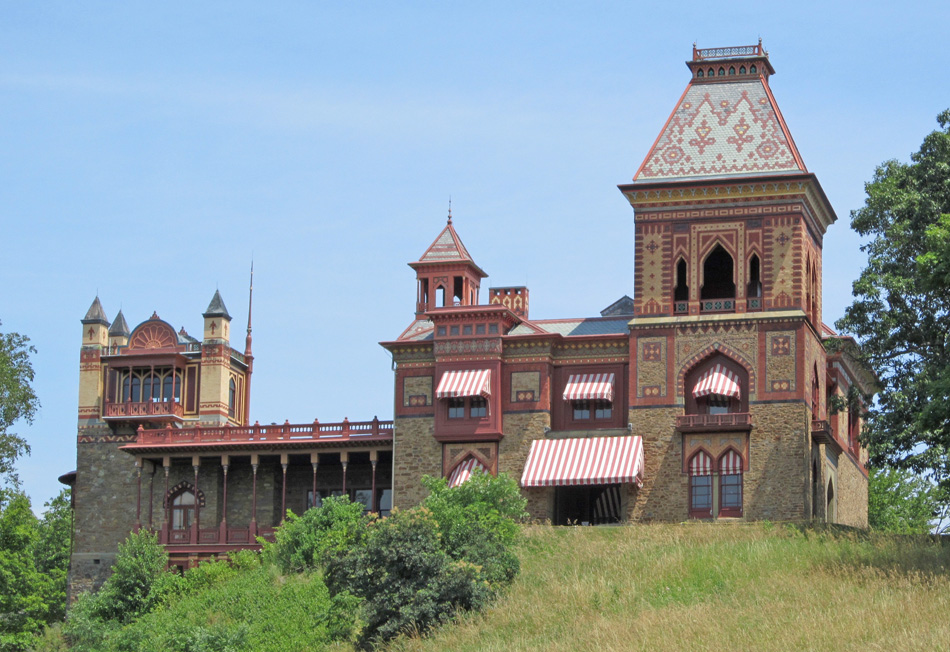 NY14a – Moorish Revival
NY14a – Moorish RevivalHudson, NY
This is the house at the famous estate known as Olana, once owned by the landscape painter Frederic Church. Church was the most celebrated painter in the America of 1850 to 1875, with some of his canvases selling for $10,000 – about a million in today's money. However, his greatest artistic achievement may well be Olana itself. Church was a member of the so-called Hudson River school, and if it has been a few years since your art-history class, this was a school of art that celebrated the portrait of idealized landscapes. (It is called the Hudson River school because many of its early adherents lived along, and loved to paint, the Hudson River valley.) The entire Olana estate was designed with the picturesque in mind. It is laced with winding paths that are enclosed by the forest, only to suddenly open onto spaces which give breath-taking views of the distant Taconic Mountains, the Hudson River – and of course, the exotic house that Church designed and built. Church planted thousands of trees at Olana, created an artificial lake, and set his house on its highest hill, all for the sake of art. Olana was meant to be a living landscape portrait, not merely an oil canvas, and surprisingly enough, it was and is just that.
 NY14b – Moorish Revival
NY14b – Moorish RevivalHudson, NY
This is the back of the Olana house. The brown box-window at right is Church's studio. After 1875, Church began to experience difficulties in selling his canvases. Landscape painting was falling out of favor with the public as French Impressionism and other modern schools of art came to the fore. By 1900, at the time of his death, the man who had once been the nation's most famous artist was virtually forgotten. Even as late as the 1950s, art historian David Huntington was told that his choice of Church as a PhD thesis topic was ill-advised, because Church (and other artists like him) were considered to be little more than insignificant illustrators by the art world. But in 1964, when the owners of Olana were planning to sell the property to real-estate developers, Huntington led the charge to save it, doing yeoman work to raise public consciousness about the importance of the property and of Church's art. The effort culminated in a feature article in Life magazine entitled "Must This Mansion Be Destroyed?", which reintroduced America to Church and convinced the New York legislature to purchase Olana and make it a state historical site. Today, Church's paintings once again sell for millions.
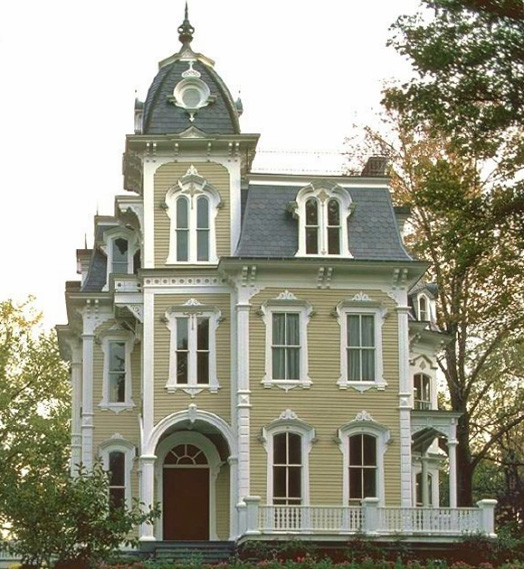 NY15 – Second Empire
NY15 – Second EmpireRhinebeck, NY
I travelled to Rhinebeck, NY mostly because I wanted to take some photos of this house, known as Croft's Villa. (Croft was the mail-order architect who designed the house, not the owner.) Unfortunately, small saplings have a tendency to become large trees, and today you couldn't take a decent photo of this house with an X-ray machine, at least not from any spot on the sidewalk. (Insert peevish rant about too many trees here.) I pilfered this photo off the internet, because the Villa is reasonably famous among Victorian house enthusiasts.
Indeed, the perspicacious reader will no doubt have already noticed that the background wallpaper of this website is a very faint tiling of none other than this very house . . .
Note that this house is subtly more expensive and thus more grand then house NY16 below, in several ways. The roof on Croft's Villa is curved, which is more expensive than the straight tower roof on NY16. Its corner quoins are elaborately carved, as opposed to the very plain quoins below. The entrance is set back under a grand arch, with a column supporting the tower, whereas the entrance on NY16 is just a door with a little roof over it. And so it goes. The Victorians loved to put their money where you could see it.
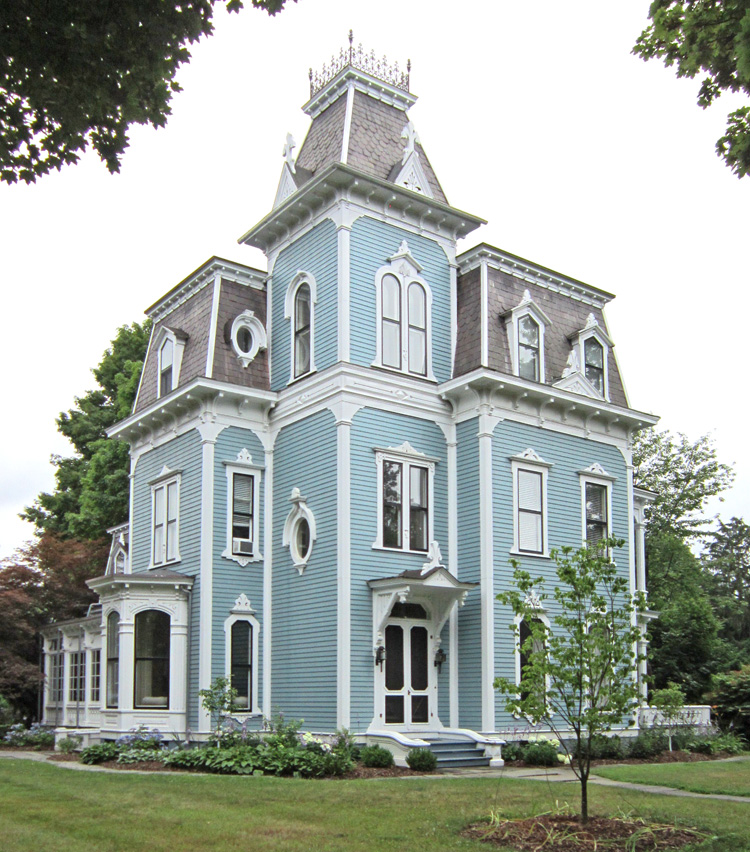 NY16a – Second Empire
NY16a – Second EmpireRhinebeck, NY
Fortunately, as it happens, Rhinebeck has other wonderful Victorians besides Croft's Villa, and this is one of them. I found this house on the internet by accident, because it happened to be for sale while I was visiting the town. And no, I do not know what the asking price was.
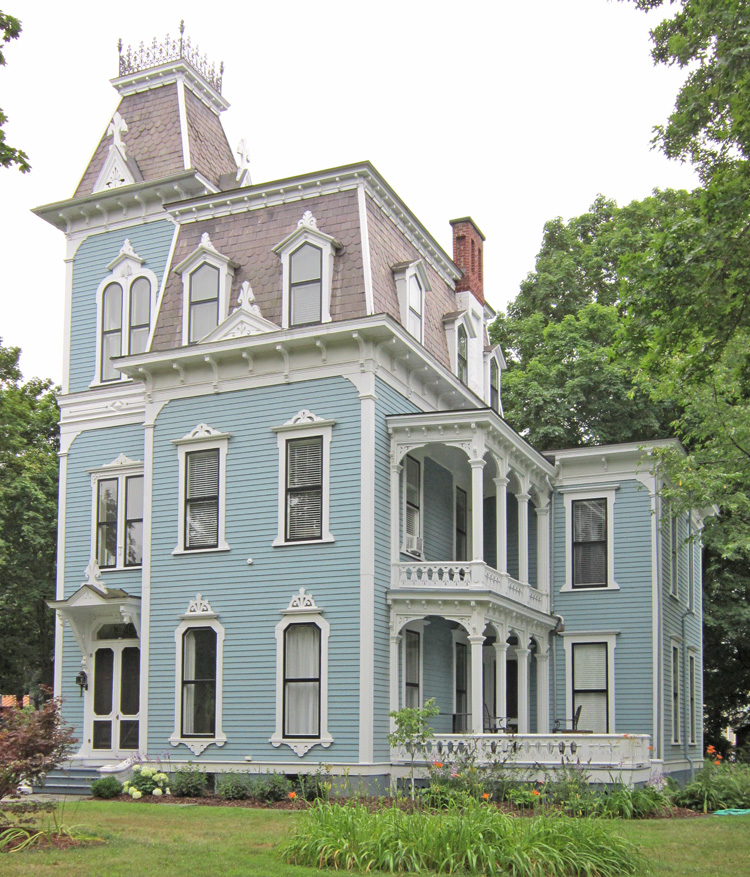 NY16b – Second Empire
NY16b – Second EmpireRhinebeck, NY
Unlike Croft's Villa, this house has no trees in front of it at all, so I was able to take this second photo of it which shows off the nice double porch on its west side.
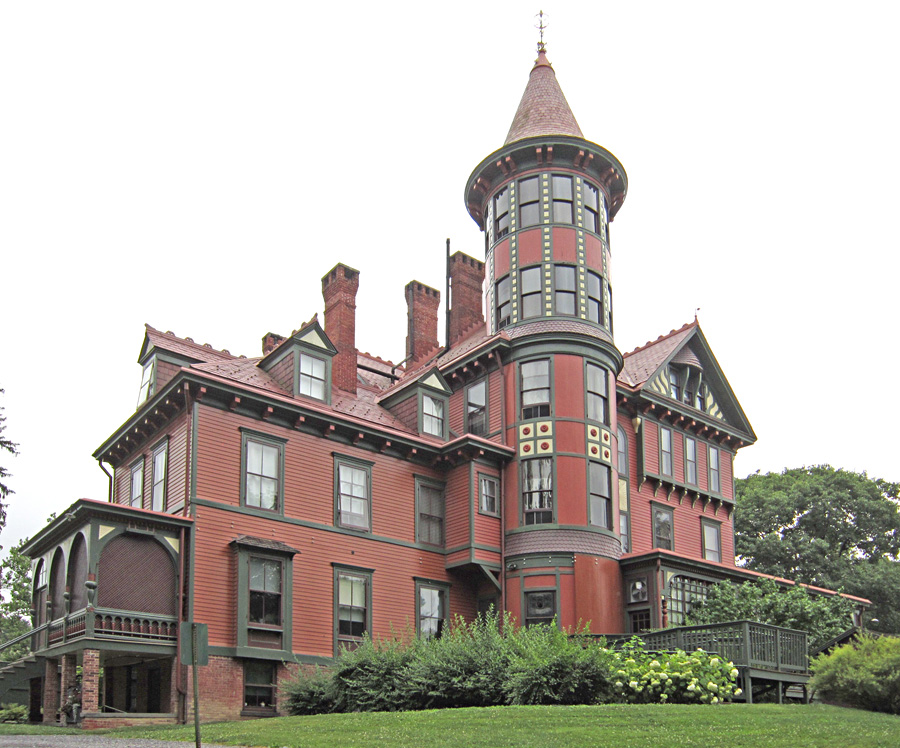 NY17a – Queen Anne
NY17a – Queen AnneRhinebeck, NY
This house is known as Wilderstein, which is
sort-of German for "wild man's stone". The name is a rather condescending reference to a Native American petroglyph which was found on the property. Wilderstein was built as a summer home for the Suckley family over the period 1852 to 1888. It started life as a modest Italianate box, but was eventually renovated and enlarged into the Queen Anne beauty that we see today. It of course sits on a hill and has a splendid view of the Hudson River.
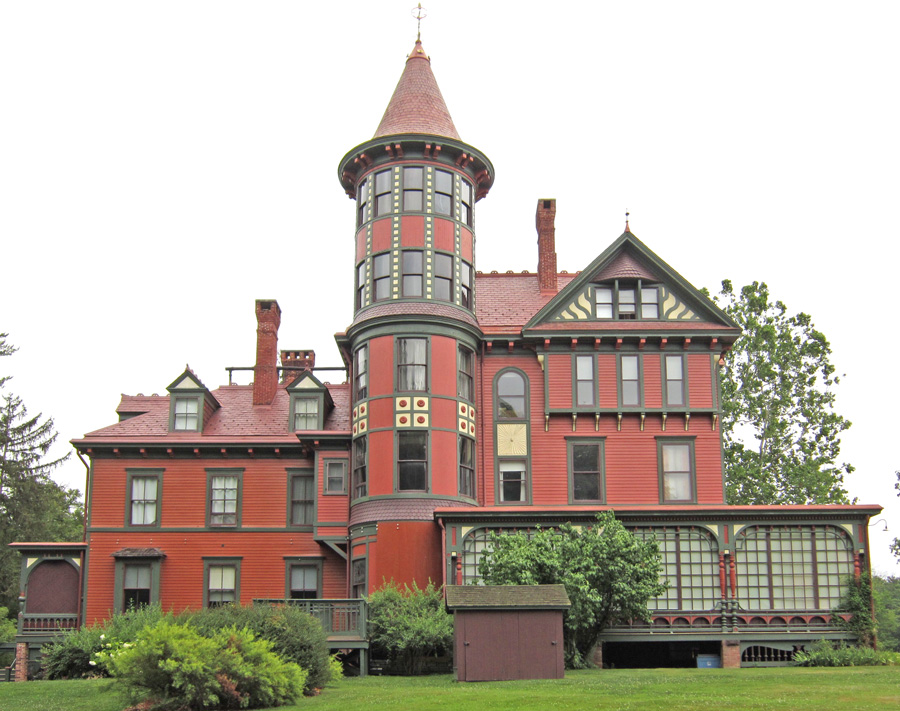 NY17b – Queen Anne
NY17b – Queen AnneRhinebeck, NY
Here is a more direct view of the southern side of the house.
 NY17c – Queen Anne
NY17c – Queen AnneRhinebeck, NY
This is a view of the back of the house, featuring the large porte cochere where horse-drawn carriages could let off their passengers. (Although, given Wilderstein's remote rural location, I suspect that in the early days most guests arrived by boat.) The Suckleys were among the Hudson Valley elite when they built the house, but unfortunately they lost most of their money during the stock market crash of 1893, and for years after that they struggled to maintain the property. The last resident of Wilderstein was Daisy Suckley, who happened to be a close friend of another Hudson Valley resident, Franklin Delano Roosevelt. (His property lay about nine miles up-river.) Daisy, who never married, lived to be 100 and died at Wilderstein in 1991. By that time the house was nearly a wreck, with a leaking roof, cracked plaster everywhere, fallen-down porches, and an exterior so worn that it essentially had no paint left on it. The house was left to a nonprofit organization which has done a heroic job of restoring it.
 NY18 – Italianate
NY18 – ItalianateKinderhook, NY
This house, known as Lindenwald, was once the home of President Martin van Buren. He lived in the house from 1841 to 1862, during which time he was extensively engaged in politics and tried twice (with two different parties) to return to the White House, but failed. Like many houses of this period, Lindenwald began its existence as a simple farm house, but was later enlarged and renovated into a more fashionable Victorian style, in this case the Italianate. Lindenwald is owned by the National Park Service today, and is open to the public.